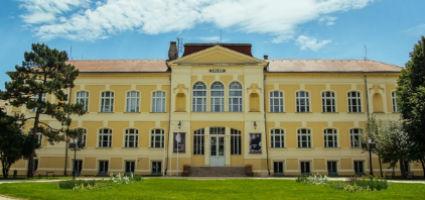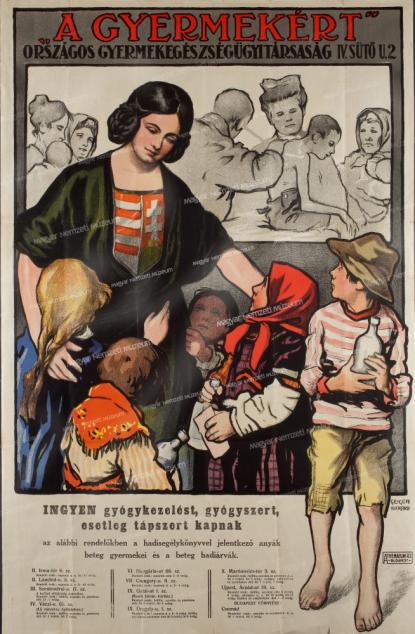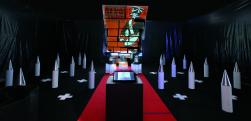2024. April 25. Thursday
Savaria Museum (Vas County Museums Authority) - Szombathely
 |
Address: 9700, Szombathely Kisfaludy Sándor utca 9.
Phone number: (94) 500-720, (94) 501-948
E-mail: info@savariamuseum.hu
Opening hours: Tue-Sun 10-18
|
The exhibition has closed for visitors.
Museum tickets, service costs:
|
Ticket for adults
|
1600 HUF
|
|
|
Ticket for students
|
800 HUF
|
|
|
Group ticket for students
(over 15 people)
|
600 HUF
|
|
|
Ticket for pensioners
|
800 HUF
|
|
|
Ticket for families
(2 adults + min. 2 children)
|
2400 HUF
|
/ family
|
|
Guide
|
5000 HUF
|
|
|
Guide
|
8000 HUF
|
Swinging over from peace times to war.
 To remember what the Great War swept away?
To remember what the Great War swept away?
To recognize all that a new, modern century bought along?
To recognize power of the crowd in the weight of centuries?
To relive the true horrors of war and the losses?
General attitude of the public and shaping public opinion, war propaganda in the hinterland?
The Hungarian National Museum's exhibition World swept away / Poster-dreams 1910–1920 raises questions about one of the most turbulent decades of 20th century. The National Museum selected 147 from its own collection of 45,000 pieces, mostly never before shown pieces consisting of original lithograph posters that were placed into a visual world that evokes emotions while raising several questions that are still waiting for an answer. Colourful posters from the last decades of the Austro-Hungarian Empire show the daily life during the pre-war years, and the reality of the battlefield, the Romanian military occupation and the 1920 Treaty of Trianon - through changes in street posters and that of public opinion.
While we enjoy masterpieces by first-class Hungarian artists addressing the masses, symbols of the exhibition evoke the world of dreams and reality, how they got entangled, then the horror that the entangled reality and dreams brought along. I wonder if the commoner could have a break, even for a minute, from the harsh reality, from the ominous shadows that were whispering about the future.
At the beginning of the exhibition we see colourful mirror pieces taking the shape of reality, in the second room we enter another world instead of the old one that was swept away. First we see the mass requisite of the hinterland that shaped the public opinion, feeling the strength of war propaganda, the incredible importance which was just being recognised by modern powers. The third room is the memento room, the place of recognitions, in which we try to point out how the real face of the war showed through bitter war years, with increasingly alluring promise of fast victory. The last exhibition space reveals a whole new world based on completely different laws, full of baleful political events.
The point of view set up for the visitors here is from a trench, that of a commoner, the dreamer, the man displaced in war, who remembers the world he had left behind, he remembers civilian life, with colourful and playful posters all around, the heroic world of posters supporting the war, and suddenly it occurs to him that revolutions often end in occupation and loss of territory.
The temporary exhibition also features the theme First World War - according to the museum's historical characteristics - it surpasses the best of lithographs gallery-like technique and attempts to implement an exhibition contrapuntal by museum relics and memorabilia only. Posters from the last ten years of the so-called "Peacetime" from the hinterland are faced by another reality of the front and battlefields. In addition to the posters artefacts, World War II relics from the museum collection (bells, military mortars, ring glasses, "Pro Patria" - military rings, porcelain relics with stickers, viva strips) works made in the trenches as well as texts, regulations, and interesting teletext pages enrich the exhibition. Social and political disorganization that occurred in the Carpathian Basin while Europe waltzed into the war, the 1918 fall revolutionary turmoil, the 1919 Spring Bolshevik coup and the desperate land protection heralding world-famous expressive poster frescoes were followed by the bitter Treaty of Trianon in 1920 and the entailing graphic footprint with which the exhibition ends.
The artists are featuring acknowledged painters and graphic artists of the 1910–1920 (Dezső Bér, Mihály Bíró, Sándor Bortnyik, Ödön Dankó, Lajos Dezső, Géza Faragó, Imre Földes, Arnold Gara, Richárd Geiger, Aranka Győri, Ödön Haranghy, Ernő Jeges, János Kmetty, Manno Miltiades, Béla Moldován, József Nemes, Lampérth, Tibor Pólya, Bertalan Pór, Jenő Pais-Goebel, Lipót Sátori, János Tábor, Márton Tuszkay, Béla Uitz, Miklós Vadász, Gusztáv Végh, Antal Weis ), whose strength lays in the fact that they managed to expose their ideas in a comprehensible language reflecting on the events, environment, lifestyle of their age, yet sometimes only reflecting on the surface. Still, through their works, we get additional information, combined with fascinating visual experience on the lifestyle of the era and gain valuable cultural historical information from them.
 To remember what the Great War swept away?
To remember what the Great War swept away?To recognize all that a new, modern century bought along?
To recognize power of the crowd in the weight of centuries?
To relive the true horrors of war and the losses?
General attitude of the public and shaping public opinion, war propaganda in the hinterland?
The Hungarian National Museum's exhibition World swept away / Poster-dreams 1910–1920 raises questions about one of the most turbulent decades of 20th century. The National Museum selected 147 from its own collection of 45,000 pieces, mostly never before shown pieces consisting of original lithograph posters that were placed into a visual world that evokes emotions while raising several questions that are still waiting for an answer. Colourful posters from the last decades of the Austro-Hungarian Empire show the daily life during the pre-war years, and the reality of the battlefield, the Romanian military occupation and the 1920 Treaty of Trianon - through changes in street posters and that of public opinion.
While we enjoy masterpieces by first-class Hungarian artists addressing the masses, symbols of the exhibition evoke the world of dreams and reality, how they got entangled, then the horror that the entangled reality and dreams brought along. I wonder if the commoner could have a break, even for a minute, from the harsh reality, from the ominous shadows that were whispering about the future.
At the beginning of the exhibition we see colourful mirror pieces taking the shape of reality, in the second room we enter another world instead of the old one that was swept away. First we see the mass requisite of the hinterland that shaped the public opinion, feeling the strength of war propaganda, the incredible importance which was just being recognised by modern powers. The third room is the memento room, the place of recognitions, in which we try to point out how the real face of the war showed through bitter war years, with increasingly alluring promise of fast victory. The last exhibition space reveals a whole new world based on completely different laws, full of baleful political events.
The point of view set up for the visitors here is from a trench, that of a commoner, the dreamer, the man displaced in war, who remembers the world he had left behind, he remembers civilian life, with colourful and playful posters all around, the heroic world of posters supporting the war, and suddenly it occurs to him that revolutions often end in occupation and loss of territory.
The temporary exhibition also features the theme First World War - according to the museum's historical characteristics - it surpasses the best of lithographs gallery-like technique and attempts to implement an exhibition contrapuntal by museum relics and memorabilia only. Posters from the last ten years of the so-called "Peacetime" from the hinterland are faced by another reality of the front and battlefields. In addition to the posters artefacts, World War II relics from the museum collection (bells, military mortars, ring glasses, "Pro Patria" - military rings, porcelain relics with stickers, viva strips) works made in the trenches as well as texts, regulations, and interesting teletext pages enrich the exhibition. Social and political disorganization that occurred in the Carpathian Basin while Europe waltzed into the war, the 1918 fall revolutionary turmoil, the 1919 Spring Bolshevik coup and the desperate land protection heralding world-famous expressive poster frescoes were followed by the bitter Treaty of Trianon in 1920 and the entailing graphic footprint with which the exhibition ends.
The artists are featuring acknowledged painters and graphic artists of the 1910–1920 (Dezső Bér, Mihály Bíró, Sándor Bortnyik, Ödön Dankó, Lajos Dezső, Géza Faragó, Imre Földes, Arnold Gara, Richárd Geiger, Aranka Győri, Ödön Haranghy, Ernő Jeges, János Kmetty, Manno Miltiades, Béla Moldován, József Nemes, Lampérth, Tibor Pólya, Bertalan Pór, Jenő Pais-Goebel, Lipót Sátori, János Tábor, Márton Tuszkay, Béla Uitz, Miklós Vadász, Gusztáv Végh, Antal Weis ), whose strength lays in the fact that they managed to expose their ideas in a comprehensible language reflecting on the events, environment, lifestyle of their age, yet sometimes only reflecting on the surface. Still, through their works, we get additional information, combined with fascinating visual experience on the lifestyle of the era and gain valuable cultural historical information from them.

